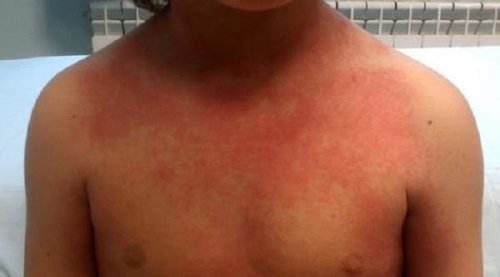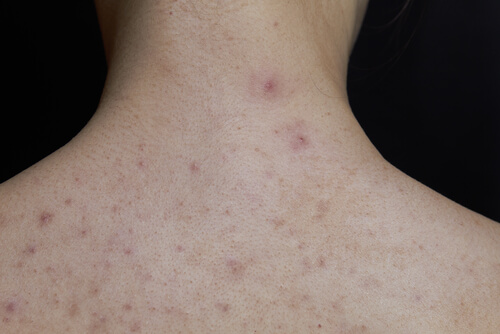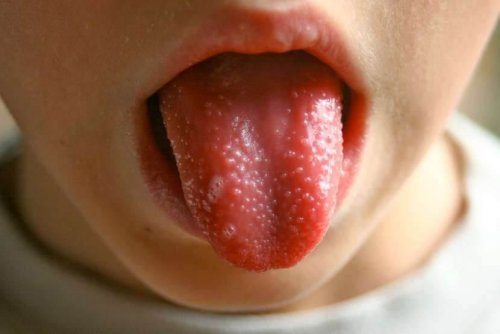Scarlet Fever in Children: What You Should Know

Health is one of those topics that is always on a parent’s mind. It is important to be aware of the most common childhood illnesses in order to prevent and treat them in time. Scarlet fever is one of them.
What is scarlet fever?
Scarlet fever is an infection caused by a streptococcus group A bacteria. This germ is capable of producing a toxin that certain people are sensitive to.
It is important to keep in mind that not all group A streptococcus bacteria produce toxins. Additionally, not everyone is sensitive to their effects.
Scarlet fever in children is most common between 4 and 8 years of age, and rarely occurs in children under 2.
Causes of scarlet fever
Type A strep tends to infect mucous membranes. It is most commonly transmitted in small drops of infected saliva. These are released into the environment when someone coughs or sneezes.
It is possible to catch scarlet fever in other ways, but these are much less common. Examples include poorly washed food or toys, or any item that a child may put into their mouth. It can also be transmitted in pus, but few cases of this have been documented.
Scarlet fever has an incubation period of one to three days. Incubation is the time that passes between the moment of infection and the appearance of the first symptoms. During this incubation period, children may infect other people.
One of the most common places to catch scarlet fever is at school. The infection is particularly virulent during the winter season.

Symptoms of scarlet fever in children
This infection manifests in two stages. In the initial phase, there are some warning signs, which are easy to confuse with tonsillitis. The symptoms are extremely similar.
This period is often characterized by a high fever, which comes on suddenly. Along with the fever, children may have a sore throat and headache.
Vomiting is not common, but may also be a symptom. Additionally, some people will suffer from stomachache and a feeling of exhaustion.
The second phase of scarlet fever involves a skin rash (also known as an exanthem). This is the most characteristic feature of scarlet fever, which gives the infection its common name.
The rash appears initially as a reddish (scarlet) flush on the child’s face and neck. The rash then expands downwards over the rest of their body.
At first, the scarlet fever rash may look just like a sunburn. When pressed with a finger, the skin loses its red color. Later on, the skin remains reddish, with tiny spots.
Another important characteristic of scarlet fever is that the rash affects the elbows, the back of the knees and the armpits. The rash tends to be more severe around folds in the skin.
It generally does not attack the area between the nose and mouth. Along with the skin rash, the tongue may take on a deep red color, and the glands in the neck will be swollen to the touch.

Around 5 days after the rash first appears, it will start to fade. After this time, the skin affected by the rash will peel, like after a sunburn. It can take up to 8 weeks for the skin to return to normal.
How is scarlet fever diagnosed and treated?
Apart from the visible symptoms, a throat culture is the most effective method of diagnosing scarlet fever and ruling out other illnesses. This is a laboratory analysis which will immediately detect the presence of scarlet fever.
In any case, it is important to keep children away from people who have or may have scarlet fever, to avoid spreading the bacteria.
This childhood illness is treated using antibiotics, usually penicillin or amoxycillin. The course of antibiotics will last at least 6 days.
Scarlet fever in children is not normally serious, and is becoming less common. If properly treated, a scarlet fever infection should not be anything for parents to worry about.
All cited sources were thoroughly reviewed by our team to ensure their quality, reliability, currency, and validity. The bibliography of this article was considered reliable and of academic or scientific accuracy.
- Basetti, S et al. “Scarlet fever: a guide for general practitioners.” London journal of primary care vol. 9,5 77-79. 11 Aug. 2017, doi:10.1080/17571472.2017.1365677
- Palacios-López CG, Durán-Mckinster C, OrozcoCovarrubias L, Saéz-de-Ocariz M, García-Romero MT, Ruiz-Maldonado R. Exantemas en pediatría. Acta Pediatr Mex 2015;36:412-423.
- Wessels MR. Pharyngitis and Scarlet Fever. 2016 Feb 10 [Updated 2016 Mar 25]. In: Ferretti JJ, Stevens DL, Fischetti VA, editors. Streptococcus pyogenes : Basic Biology to Clinical Manifestations [Internet]. Oklahoma City (OK): University of Oklahoma Health Sciences Center; 2016-. Available from: https://www.ncbi.nlm.nih.gov/books/NBK333418/